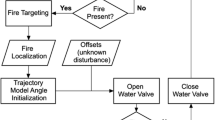Abstract
An infrared image-based feedback control system for intelligent fire monitor was proposed in this paper, whose aims are to realize automatic aiming of the fire site and continuous fire tracking in the process of fire extinguishing through adjusting of the yaw angle of the fire monitor. Firstly, infrared camera was used to capture images of the fire site, and under high temperatures, the fire would be easily observed. An improved adaptive image threshold segmentation scheme was developed for image background segmentation and fire acquisition. The fire region in the captured image was considered as region of interest (ROI) and the geometric center of which was calculated. Due to the special advantageous structural design of the proposed system, the geometric center of ROI representing the actual fire was considered as the direction which the fire monitor should aim at. Furthermore, a fuzzy control scheme simulating the operating mode of firefighters was proposed, and the ROI center position deviation and deviation rate were considered as inputs of the control system. Experimental results show that, after the fire was detected by the system, the fire monitor could be yawed to the direction of the fire within 2000 ms, and the deviation of image position is less than 1.6 pixels. Similarly, the proposed system could be well adapted to the changing position of the fire caused by combustion. And after no more than image iteration of three frames, the controller realizes aiming of the fire by the fire monitor, and the final deviation is less than 0.1 pixels. In general, the proposed infrared image feedback control system for fire horizontal position aiming of intelligent fire monitor has great potential for intelligent fire extinguishing by fire-fighting robots.












Similar content being viewed by others
References
China Fire Protection Association (2018) Statistical report of the 17th international fire equipment and technology exchange exhibition. Fire Sci Technol 15:23–34
Min X (2015) On-the-spot characteristics of extra serious explosion accident in Tianjin port on August 12. City Disaster Reduct 5:9–12
Su KL (2006) Automatic fire detection system using adaptive fusion algorithm for fire firghting robot. In: IEEE international conference on systems
Kim JH, Keller B, Lattimer BY (2013) Sensor fusion based seek-and-find fire algorithm for intelligent firefighting robot. In: IEEE/ASME international conference on advanced intelligent mechatronics. https://doi.org/10.1109/AIM.2013.6584304
Sandeep GSP (2014) A computer vision based approach for detection of fire and direction control for enhanced operation of fire fighting robot. In: International conference on control. https://doi.org/10.1109/CARE.2013.6733740
Bose J, Mehrez SC (2017) Development and designing of fire fighter robotics using cyber security. In: International conference on anti-cyber crimes, pp 118–122. https://doi.org/10.1109/Anti-Cybercrime.2017.7905275
Qian J, Zeng JJ, Yang RQ, Weng XH (2006) A fire scout robot with accurate returning for urban environment. Robotica 25(3):351–358. https://doi.org/10.1017/S0263574706003146
Cai L, Zhang R (2013) Design and research of intelligent fire-fighting robot. Adv Mater Res 823:358–362. https://doi.org/10.4028/www.scientific.net/AMR.823.358
Jia YZ, Li JS, Guo N, Jia QS, Du BF, Chen CY (2018) Design and research of small crawler fire fighting robot. Chin Autom Congress 823:4120–4123.
Prabha PS, Shivaanivarsha N (2017) A design of firefighting and supervising self-sufficient robots. In: 3rd IEEE international conference on science technology engineering and management
Gao S, Zhang ZY, Zhao ZH, Jamali MM (2018) Vision and infra-red sensor based fire fighting robot. In: 61st IEEE international midwest symposium on circuits and systems. https://doi.org/10.1109/MWSCAS.2018.8624080
Siregar B, Purba HA, Efendi S, Fahmi F (2017) Fire extinguisher robot using ultrasonic camera and wifi network controlled with android smartphone. In: Materials science and engineering conference series
McNeil JG, Lattimer BY (2017) Robotic fire suppression through autonomous feedback control. Fire Technol 53(3):1171–1199 https://doi.org/10.1007/s10694-016-0623-1
McNeil JG, Lattimer BY (2016) Autonomous fire suppression system for use in high and low visibility environments by visual servoing. Fire Technol 52(5):1343–1368 https://doi.org/10.1007/s10694-016-0564-8
McNeil JG, Lattimer BY (2015) Real-time classification of water spray and leaks for robotic firefighting. IGI Glob 1:1-26
Kim JH, Starr JW, Lattimer BY (2015) Firefighting robot stereo infrared vision and radar sensor fusion for imaging through smoke. Fire Technol 51(4)823–845. https://doi.org/10.1007/s10694-014-0413-6
Kim JH, Lattimer BY (2015) Real-time probabilistic classification of fire and smoke using thermal imagery for intelligent firefighting robot. Fire Saf J 72:40–49. https://doi.org/10.1016/j.firesaf.2015.02.007
Starr JW, Lattimer BY (2013) Application of thermal infrared stereo vision in fire environments. In: IEEE/ASME international conference on advanced intelligent mechatronics. https://doi.org/10.1109/AIM.2013.6584337
Xu X, Xu S, Jin L, Song E (2011) Characteristic analysis of Otsu threshold and its applications. Pattern Recogn Lett 32(7):956–961. https://doi.org/10.1016/j.patrec.2011.01.021
Gull SF, Skilling J (1984) Maximum entropy method in image processing. Commun Radar Signal Proces IEE Proc F 131(6):646–659. https://doi.org/10.1049/ip-f-1:19840099
Stuller JA (1995) A two-dimensional image model based on occlusion and maximum entropy. In: Conference on signals, systems and computers. https://doi.org/10.1109/ACSSC.1995.540935
Chen HK, Yang XL (2012) Improved two-dimensional maximum entropy segmentation algorithm for infrared images based on fractal theory. Infrared 33(8):27–31. https://doi.org/10.3969/j.issn.1672-8785.2012.08.005
Santis AD, Siciliano B, Villani L (2008) A unified fuzzy logic approach to trajectory planning and inverse kinematics for a fire fighting robot operating in tunnels. Intel Serv Robot 1:41–49
Acknowledgements
This work is supported by National Key R&D Program of China (2016YFC0802900) and Xu-gong Construction Machinery Group (XCMG) Research Institute and a Project Funded by the Priority Academic Program Development of Jiangsu Higher Education Institutions, Top-notch Academic Programs Project of Jiangsu Higher Education Institutions.
Author information
Authors and Affiliations
Corresponding author
Additional information
Publisher's Note
Springer Nature remains neutral with regard to jurisdictional claims in published maps and institutional affiliations.
Rights and permissions
About this article
Cite this article
Zhu, J., Li, W., Lin, D. et al. Intelligent Fire Monitor for Fire Robot Based on Infrared Image Feedback Control. Fire Technol 56, 2089–2109 (2020). https://doi.org/10.1007/s10694-020-00964-4
Received:
Accepted:
Published:
Issue Date:
DOI: https://doi.org/10.1007/s10694-020-00964-4




